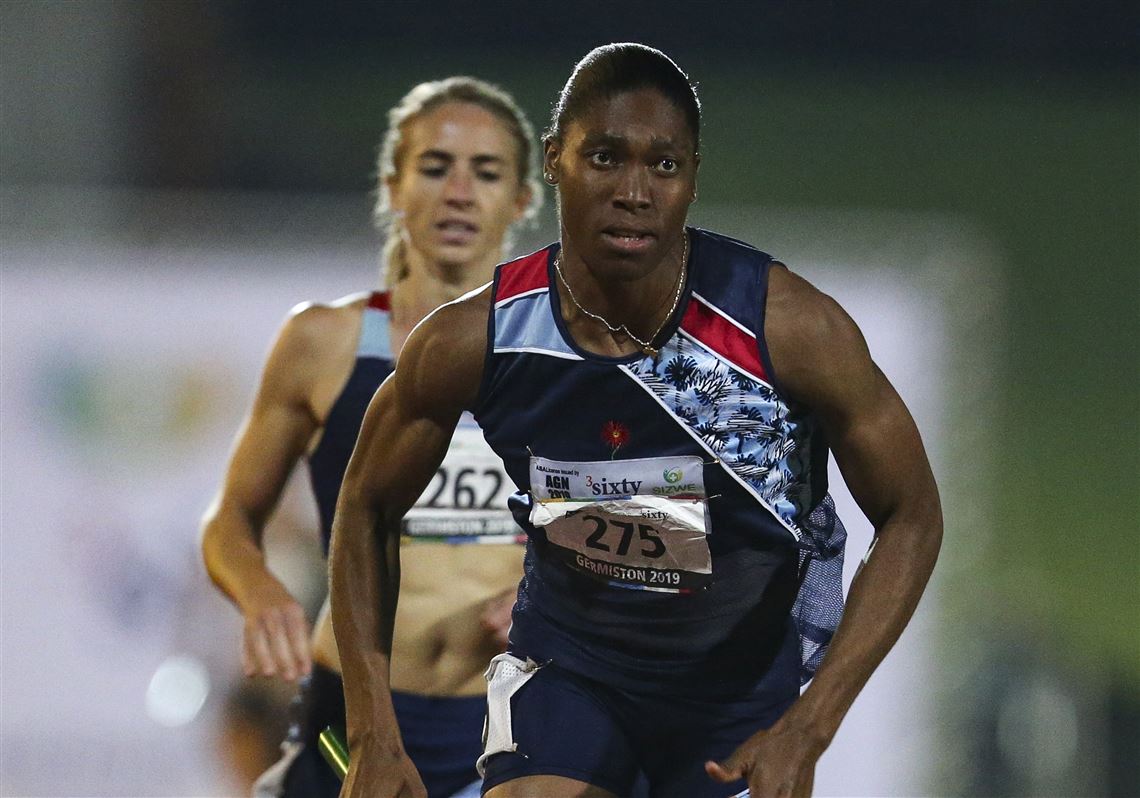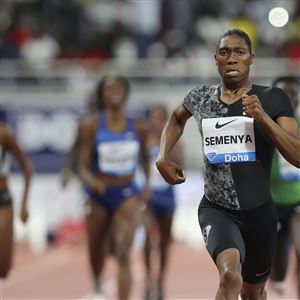In ruling against Olympic gold medalist Caster Semenya, the highest court in international sports effectively imposed an exacting, mathematical definition of who should be considered male or female based on a single factor - testosterone levels.
The Wednesday decision by the Court of Arbitration for Sport — one of the most ethically and scientifically challenging cases in modern sports law — has prompted an outcry from human rights groups and medical researchers who call the idea “unscientific” and say it sets a dangerous precedent for using biological measures to justify discrimination.
Ms. Semenya - a South African national who is one of the world’s fastest female runners - is believed to have hyperandrogenism in which the body naturally produces levels of hormones that are more typical of men. She has protested a 2018 rule from the International Association of Athletics Federations as discrimination because it requires female athletes with testosterone output higher than a certain cutoff to take medications to suppress levels of the hormone to continue competing.
The World Medical Association on Wednesday called on doctors around the world not to implement the IAAF’s rule. Its president, Leonid Eidelman of Israel, said in a statement: “We have strong reservations about the ethical validity of these regulations. They are based on weak evidence from a single study, which is currently being widely debated by the scientific community.”
A group of scientists has charged that the IAAF relied on faulty data in trying to establish the precise advantages of athletes with elevated testosterone levels. Ms. Semenya’s lawyers and other supporters have argued that science has not conclusively shown that elevated testosterone provides women with more of a significant competitive edge than factors like nutrition, access to coaching and training facilities, and other genetic and biological variations.
One of the leading sport science experts who have supported Semenyna included Ross Tucker, who testified on the runner’s behalf and boasts of a Ph.D. in exercise physiology.
"The decision was a disappointment to me, because of the scientific matters and in particular the scientific process that was followed in supporting those regulations," wrote Mr. Tucker. "In my reading of the situation, there is insufficient evidence to support the regulations. There is concept, theory, and biological rationale, but not evidence. And the regulations are, for all intents and purposes, an evidence-based document."
He also said that as a result of the court decision, other sports will essentially copy the IAAF’s regulations.
“For them, every fear and concern they had that they will be in the spotlight for introducing similar rules will be gone,” Mr. Tucker said. “Other sports will be super happy because the pressure’s off to develop their own regulations.”
The IAAF has said the rules are only meant to ensure “fair and meaningful competition,” and are not a judgment on any athlete’s sex or gender identity.
Ms. Semenya has faced questions about her body since 2009, when she won the 800 meter world championships at age 18, and she said this week that she believes the IAAF’s attempts at regulations “have always targeted me specifically.”
Ms. Semenya’s fight is part of a larger conversation about intersex conditions, in which individuals have a mix of characteristics that are typically associated with one sex or another. In some cases, men or boys with male external reproductive organs have internal ovaries, or women or girls with external female anatomy may have internal testes. Some people’s reproductive organs may present as a combination of male and female. Others may appear typically female but have unusually high levels of testosterone, or appear typically male but have XX chromosomes.
One paper, by Anne Fausto-Sterling, a professor of biology and gender studies at Brown University, found that as many as 1.7 percent of the population — or 1 out of every 60 people — may be intersex. Another peer-reviewed paper used different methods to define intersex and estimated the condition to be rarer - closer to 0.018 percent.
There are 50 to 60 distinct intersex subtypes, most of them genetic, that impact sex hormones, testes and ovaries, or genitals. Public awareness of the conditions has been growing thanks to shows such as the MTV series, “Faking It,” which features intersex mean girl Lauren Cooper, and “Freaks and Geeks,” in which one of the lead characters is dating a girl who reveals she was born with both female and male reproductive organs. In addition, numerous first-person accounts have been published recently in prominent outlets such as USA Today and The New York Times making the case for more openness and for doing away with a strict gender binary that defines everyone as either a woman or man.
As many parts of the world have come to embrace a broader view of gender identity, legislatures in several countries and at least four U.S. states have moved to ban medically unnecessary surgeries on intersex minors to make their external genitalia more typical of one sex. Critics of this practice argue the conditions are not something that needs to be “corrected,” but part of the natural diversity of humans.
“That’s an area of huge controversy - a decision being made at a time when a child cannot participate,” said Yee-Ming Chan, a pediatric endocrinologist at Harvard.
Ms. Semenya’s case is centered on an intersex condition that involves testosterone, a hormone that has an almost mythical reputation. It’s associated with muscle mass, bone density, fat distribution and development of sex organs. It’s used illicitly to increase strength and performance. Too little has been blamed for meekness, too much of it for Type A macho.
The Switzerland-based Court of Arbitration for Sport said Wednesday that female track athletes with elevated testosterone won’t be able to compete at events such as the Olympics unless they take medications to suppress those levels.
The IAAF switched to a testosterone-based test that was initially shot down in 2015, when Indian sprinter Dutee Chand prevailed in her appeal. In that ruling, the CAS asked for more scientific evidence.
The “normal” female range, as defined by the IAAF, is below 2 nanomole per liter in the blood, and the normal male range is 7.7 to 29.4 nanomole per liter. In a rule issued in 2018, the IAAF decreed that women who have levels above 5 nanomole per liter take measures to reduce that level to below 5 nanomole per liter through the use of medications such as oral contraceptives to continue competing.
But Justin Garcia, research director of Indiana University’s Kinsey Institute, which focuses on gender and sexuality, said gender cannot be that easily defined. Both men and women produce testosterone, and the typical man produces more than the typical woman. But there is huge variation among individuals, he said, with a significant percentage of women having higher levels than many men. Some studies have shown, for example, that women who seek out risky careers such as finance are more likely to have elevated testosterone levels.
“The notion that there is just male and female is patently unsupported by evolutionary biology and cultural evidence,” Mr. Garcia said.
It’s generally accepted that testosterone can impact sports performance. One study published in 2013 in the journal Hormones and Behavior, for instance, noted that it could not only stimulate muscle mass and reduce body fat, but may act on parts of the brain to “increase aggression and motivation for competition.”
But many experts argue that physiology is but one part of achievement in sports, and that training, perseverance and access to resources are just as important. Barring Ms. Semenya from competing, they say, would be like excluding swimmers with unusually wide arm spans or basketball players who are over 7 feet tall.
Joshua Safer, executive director of the Center for Transgender Medicine and Surgery at Mount Sinai Health System in New York City, said he’s concerned about ordering an athlete such as Ms. Semenya to reduce levels of naturally occurring testosterone when other athletes are not required to give up other natural advantages such as larger muscles.
“My fear is, if we’re dealing with naturally occurring differences, where do you draw the line?” Mr. Safer asked. “Are we drawing the line with Semenya because we’re pretty sure we know where her advantage is?”
In an opinion piece published in March in the BMJ, researchers Sheree Bekker of the University of Bath and Cara Tannenbaum of the University of Montreal argued that medical science does not define biological sex by testosterone levels and that the rules risk “setting an unscientific precedent for other cases of genetic advantage.” In April, a second pair of scientists - Eric Vilain, a genetic medicine expert at Children’s National Medical Center and Maria José Martinez-Patiño, who researches sports science at the University of Vigo - argued in the Lancet that the IAAF’s choice of 5 nanomole per liter is “arbitrary.”
“The underlying rationale perpetuates the notion that women with an intersex condition are not 100% women,” they wrote.
The United Nations Human Rights Council, which does not typically get involved in sports matters, has called the IAAF rule “unnecessary, humiliating and harmful.”
Neela Ghoshal, a senior researcher with Human Rights Watch, said it is based on outdated stereotypes of femininity. She said part of the decision about who to test is not scientific, but based on an athlete’s outward appearance. If someone looks masculine to an official, they might be singled out to have their anatomy examined and hormone levels tested.
“But a lot of people with intersex don’t know. In most regards, their appearance is fully male or female,” she explained. A woman may suddenly find out she’s been playing female sports, and she’s told, “you can’t do this unless you undergo hormone treatments, which can have all kind of side effects,” Ms. Ghoshal said.
“That’s not something the science backs up,” she said.
The Associated Press, The New York Times, CNN and Los Angeles Times contributed.
First Published: May 2, 2019, 9:59 p.m.

















